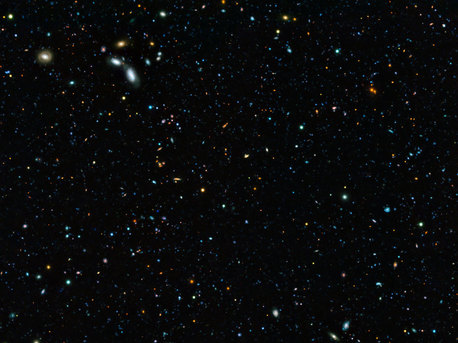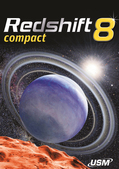Distant Galaxies Often Missed
Why Many Surveys Miss 90% Of The Targets
 © ESO/M. Hayes
|
This composite image of the GOODS-South field — the result of an extremely deep survey using two of the four giant 8.2-metre telescopes composing ESO’s Very Large Telescope (VLT) and a unique custom-built filter — shows some of the faintest galaxies ever seen. It also allows astronomers to determine that 90% of galaxies whose light took 10 billion years to reach us have gone undiscovered.
“Astronomers always knew they were missing some fraction of the galaxies in Lyman-alpha surveys,” explains Matthew Hayes, the lead author of the paper, published this week in Nature, “but for the first time we now have a measurement. The number of missed galaxies is substantial.”
To figure out how much of the total luminosity was missed, Hayes and his team surveyed the same area of space for light emitted at a different wavelength with the help of the VLT and some special filters. They specifically looked at galaxies whose light has been traveling for 10 billion years (redshift 2.2), in a well-studied area of the sky, known as the GOODS-South field.
The survey was extremely deep, and uncovered some of the faintest galaxies known at this early epoch in the life of the Universe. The astronomers could thereby conclude that traditional surveys done using Lyman-alpha only see a tiny part of the total light that is produced, since most of the Lyman-alpha photons are destroyed by interaction with the interstellar clouds of gas and dust. This effect is dramatically more significant for Lyman-alpha than for H-alpha light. As a result, many galaxies, a proportion as high as 90%, go unseen by these surveys. “If there are ten galaxies seen, there could be a hundred there,” Hayes says.
Different observational methods, targeting the light emitted at different wavelengths, will always lead to a view of the Universe that is only partially complete. The results of this survey issue a stark warning for cosmologists, as the strong Lyman-alpha signature becomes increasingly relied upon in examining the very first galaxies to form in the history of the Universe. “Now that we know how much light we’ve been missing, we can start to create far more accurate representations of the cosmos, understanding better how quickly stars have formed at different times in the life of the Universe,” says co-author Miguel Mas-Hesse.
Source: ESO
Distant Galaxies Often Missed
Why Many Surveys Miss 90% Of The Targets
 © ESO/M. Hayes
|
This composite image of the GOODS-South field — the result of an extremely deep survey using two of the four giant 8.2-metre telescopes composing ESO’s Very Large Telescope (VLT) and a unique custom-built filter — shows some of the faintest galaxies ever seen. It also allows astronomers to determine that 90% of galaxies whose light took 10 billion years to reach us have gone undiscovered.
“Astronomers always knew they were missing some fraction of the galaxies in Lyman-alpha surveys,” explains Matthew Hayes, the lead author of the paper, published this week in Nature, “but for the first time we now have a measurement. The number of missed galaxies is substantial.”
To figure out how much of the total luminosity was missed, Hayes and his team surveyed the same area of space for light emitted at a different wavelength with the help of the VLT and some special filters. They specifically looked at galaxies whose light has been traveling for 10 billion years (redshift 2.2), in a well-studied area of the sky, known as the GOODS-South field.
The survey was extremely deep, and uncovered some of the faintest galaxies known at this early epoch in the life of the Universe. The astronomers could thereby conclude that traditional surveys done using Lyman-alpha only see a tiny part of the total light that is produced, since most of the Lyman-alpha photons are destroyed by interaction with the interstellar clouds of gas and dust. This effect is dramatically more significant for Lyman-alpha than for H-alpha light. As a result, many galaxies, a proportion as high as 90%, go unseen by these surveys. “If there are ten galaxies seen, there could be a hundred there,” Hayes says.
Different observational methods, targeting the light emitted at different wavelengths, will always lead to a view of the Universe that is only partially complete. The results of this survey issue a stark warning for cosmologists, as the strong Lyman-alpha signature becomes increasingly relied upon in examining the very first galaxies to form in the history of the Universe. “Now that we know how much light we’ve been missing, we can start to create far more accurate representations of the cosmos, understanding better how quickly stars have formed at different times in the life of the Universe,” says co-author Miguel Mas-Hesse.
Source: ESO








